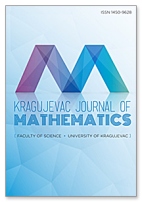Differential Invariants of Coupled Hirota-Satsuma KdV Equations
 Download PDF
Download PDF
Authors: G. HAGHIGHATDOOST, M. BAZGHANDI AND F. PASHAIE
DOI: 10.46793/KgJMat2505.793H
Abstract:
In this paper, we consider a generalized coupled Hirota-Satsuma KdV (CHSK) system of equations. We apply the moving frames method to find a finite generating set of differential invariants for the Lie symmetry group of CHSK equations. Once the generating set of differential invariants is located, we obtain recurrence relations and syzygies among the generating differential invariants. Our approach provides a complete characterization of the structure of algebras of differential invariants of CHSK equations.
Keywords:
Differential invariants, Symmetry groups, Moving frames, Coupled Hirota-Satsuma KdV equations.
References:
[1] M. B. Abd-el-Malek and A. M. Amin, Lie group method for solving generalized Hirota–Satsuma coupled Korteweg–de Vries (KdV) equations, Appl. Math. Comput. 224 (2013), 501–516.
[2] M. Bazghandi, Lie symmetries and similarity solutions of phi-four equation, Indian J. Math. 61(2) (2019), 187–197.
[3] T. B. Benjamin, J. L. Bona and J. J. Mahony, Model equations for long waves in nonlinear dispersive systems, Philos. Trans. Roy. Soc. A 272(1220) (1972), 47–78.
[4] G. W. Bluman, A. C. Cheviakov and S. C. Anco, Applications of Symmetry Methods to Partial Differential Equations, Springer, New York, 2010.
[5] J. Chen, X. Xin and Y. Chen, Non-local symmetries of the Hirota-Satsuma coupled KdV system and their applications: Exactly solvable and integrable systems, J. Math. Phys. 55(5) (2014), 1–18. https://doi.org/10.48550/arXiv.1301.0438
[6] R. Hirota and J. Satsuma, Soliton solutions of a coupled Korteweg-de Vries equation, Physical Letters A 85(8–9) (1981), 407–408.
[7] D. Hilbert, Theory of Algebraic Invariants, Cambridge Univ. Press, New York, 1993.
[8] D. Levi, L. Vinet and P. Winternitz, Symmetries and Integrability of Difference Equations, Cambridge University Press, 2011.
[9] S. Lie and S. Scheffers, Vorlesungen über Continuierliche Gruppen mit Geometrischen und Anderen Anwendungen, B.G. Teubner, Leipzig, 1893.
[10] M. Fels and P. J. Olver, Moving coframes-I: A practical algorithm, Acta Appl. Math. 51 (1998), 161–213.
[11] M. Fels and P. J. Olver, Moving coframes-II: Regularization and theoretical foundations, Acta Appl. Math. 55(2) (1999), 127–208.
[12] A. Naderifard, S. R. Hejazi and E. Dastranj, Symmetry properties, conservation laws and exact solutions of time-fractional irrigation equation, Waves Random Complex Media 29(1) (2019), 178–194.
[13] M. Nadjafikhah and V. Shirvani-Sh, Lie symmetries and conservation laws of the Hirota-Ramani equation, Commun. Nonlinear Sci. Numer. Simul. 17(11) (2012), 4064–4073.
[14] L. V. E. Ovsiannikov, Group Analysis of Differential Equations, Academic Press, 2014.
[15] P. J. Olver, Applications of Lie Groups to Differential Equations, Vol. 107, Springer Science & Business Media, 1993.
[16] P. J. Olver, Equivalence, Invariants and Symmetry, Cambridge University Press, 1995.
[17] P. J. Olver, Lectures on Moving Frames, University of Minnesota, Minneapolis, 2018.
[18] P. J. Olver, Differential invariants of surfaces, Differential Geom. Appl. 27(2) (2009), 230–239.
[19] P. J. Olver, Moving frames and singularities of prolonged group actions, Selecta Math. 6(1) (2000), 41–77.
[20] P. J. Olver and J. Pohjanpelto, Maurer-Cartan forms and the structure of Lie pseudo-groups, Selecta Math. 11 (2005), 99–126.
[21] P. J. Olver and J. Pohjanpelto, Moving frames for Lie pseudo-groups, Canad. J. Math. 60 (2008), 1336–1386.
[22] P. J. Olver and F. Valiquette, Recursive moving frames for Lie pseudo-groups, Results Math. 73(2) (2018), 1–64. https://doi.org/10.1007/s00025-018-0818-5
[23] P. J. Olver, Generating differential invariants, J. Math. Anal. Appl. 333 (2007), 450–471.
[24] P. J. Olver and J. Pohjanpelto, Differential invariant algebras of Lie pseudo-groups, Adv. Math. 222(5) (2009), 1746–1792.
[25] P. A. Griffiths, On Cartan’s method of Lie groups and moving frames as applied to uniqueness and existence questions in differential geometry, Duke Math. J. 41 (1974), 775–814.
[26] G. G. Polat and P. J. Olver, Joint differential invariants of binary and ternary forms, Port. Math. 76(2) (2020), 169–204.
[27] K. R. Raslan, S. El-Danaf and K. A. Khalid, Collocation method with quantic b-spline method for solving hirota-satsuma coupled KDV equation, International Journal Of Applied Mathematical Research 5(2) (2016), 123–131.
[28] E. Saberi and S. R. Hejazi, Lie symmetry analysis, conservation laws and exact solutions of the time-fractional generalized Hirota-Satsuma coupled KdV system, Phys. A 492 (2018), 296–307.
[29] E. Saberi, S. R. Hejazi and A. Motamednezhad, Lie symmetry analysis, conservation laws and similarity reductions of Newell-Whitehead-Segel equation of fractional order. J. Geom. Phys. 135 (2019), 116–128.
[30] A. Tresse, Sur les invariants différentiels des groupes continus de transformations, Acta Math. 18 (1894), 1–88.
[31] Y. Wu, X. Geng, X. Hu and S. Zhu, A generalized Hirota-Satsuma coupled Korteweg-de Vries equation and Miura transformations, Phys. Lett. A 255 (1999), 259–264.
